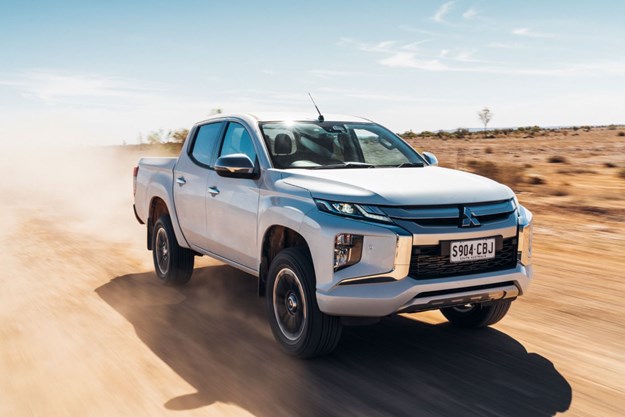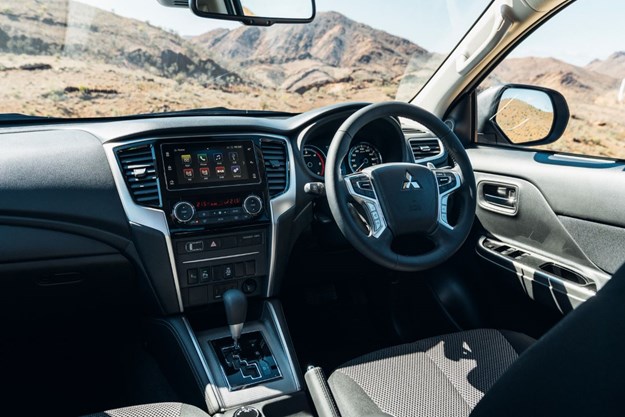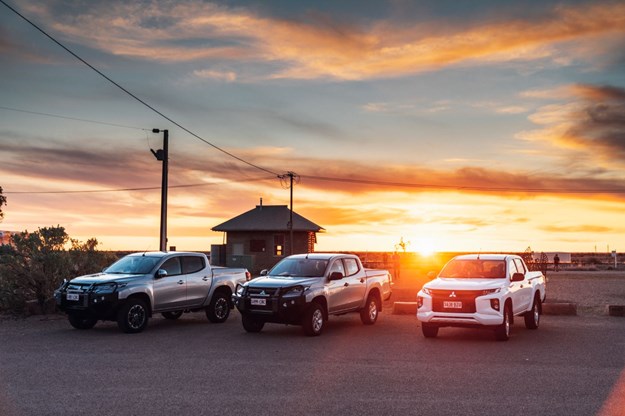Mitsubishi has made some revisions across the Triton range, with an emphasis on improved off-road capability. We sample it in the Flinders Ranges.
Keen to highlight the Triton’s off-road capability, Mitsubishi recently held the launch for the 2020 version of its popular Triton 4×4 ute at Warraweena Station in the spectacular Flinders Ranges of South Australia.
If you like scrabbling up steep rocky inclines and forging through creek beds and deep gorges, then Warraweena is the place for you, with a number of drive loops graded from ‘easy’ to ‘hard’. No matter which you decide to tackle, you’ll need a 4×4 with high ground clearance to traverse most of the 4×4 tracks on Warraweena, so it wasn’t surprising that Mitsubishi removed the sidesteps from the Tritons we sampled prior to letting us loose in the demanding conditions.
New features for MY20 Triton GLX and GLX+ models include the fitment of 245/70R16 Bridgestone Dueler all-terrain tyres, while the GLX+ also scores a standard rear diff lock (previously exclusive to the top-spec GLS Premium) and the fitment of a roof-mounted rear air circulator for better airflow inside the cabin. Both GLX and GLX+ retain Mitsubishi’s Easy-Select 4WD (essentially a fancy name for a two-speed, part-time 4×4 system).
The GLS model grade scores a standard rear diff lock for 2020, and GLS and GLS Premium models are equipped with 265/60R18 Dunlop Grandtrek highway tyres and Mitsubishi’s Super-Select 4WD-II (selectable on-demand 4×4) system. Super-Select 4WD-II incorporates an ‘Off-Road Mode’ system (available on both manual and auto variants) with ‘Gravel’, ‘Mud/Snow’, ‘Sand’ and ‘Rock’ settings, which tailors engine power delivery, automatic transmission response, traction control response and stability control reaction, to suit different driving environments. Both GLS and GLS Premium are also now equipped with keyless entry and push-button start.
The interior is unchanged, and it’s slightly narrower in the body than the competition but with reasonable leg room front and rear and good fit and finish. Tilt-and-reach steering wheel adjustment makes it easy to get comfortable behind the wheel and, while fitting three adults across the rear seat is a squeeze, the seat back has good rake. As for the roof-mounted air circulator, it works surprisingly well, pumping cool air from the front vents and moving it around the cabin efficiently.
Look back on the Triton review from our 2018 megatest, here
On the road the Triton offers a more dynamic driving experience than many of its competitors and, although ride quality is on the firm side when unladen, it’s reasonably compliant. The GLX+ felt marginally smoother over bumpy gravel roads no doubt thanks to its higher profile 245/70R16 rubber, but there’s not much in it. The GLS models have the advantage of selectable full-time 4WD, which is handy when roads change from sealed to gravel to sealed again, but with effective traction and stability control systems the part-time only set-up in the lower grade models is not a deal breaker.
The Triton’s 2.4-litre turbo-diesel (133kW at 3500rpm and 430Nm at 2500rpm) is not as potent as many of its four-cylinder competitors, but on-road performance is still impressive, thanks in part to its smooth-shifting close-ratio six-speed auto (the only transmission option on test). The engine is also relatively smooth and quiet, and in-cabin noise insulation is effective.
GLX+ models (and up) certainly benefit from the fitment of the standard rear diff lock, especially in steep and slippery terrain with ruts that see suspension travel pushed to its limits. Having said that, the traction control system is rendered inactive when the rear diff is locked, so in some off-road scenarios the Triton will actually go further with the rear diff lock disengaged. Rear axle articulation is acceptable, but it doesn’t take much for the Triton to lift a front wheel into the air in undulating terrain.
Low range gearing is respectable, with an overall reduction in first gear of 39.5:1 combining with the auto’s torque multiplying effect to make light work of most inclines. On steep downhill runs, however, lower gearing would certainly come in handy.
Hill Descent Control helps in this respect, but this is part of the ‘Off-Road Mode’ package that’s only available on GLS and GLS Premium models; so if you’re driving a GLX or GLX+ you’ll need to rely on the brakes to arrest speed. We sampled the GLS’s various ‘Off-Road Mode’ settings on the tracks around Warraweena, but other than slightly altered throttle response it was difficult to pick much of a difference.
With sidesteps removed and a claimed 205mm of ground clearance on GLX+ and 220mm on GLS models, the Tritons we sampled at Warraweena only scraped their bellies a couple of times. The biggest hits occurred when the rear bumper grounded when exiting creek beds, but this is common among dual-cab utes with their long rear overhangs.
The Triton’s payload varies from 845kg to 1095kg depending on model grade and its towing capacity is 750kg/3100kg (unbraked/braked), the latter figure down slightly on most class competitors. There are six tie-down points in the tub.
The Triton safety package is comprehensive, and all models are now available with Forward Collision Mitigation (FCM) with pedestrian detection and Lane Departure Warning (LDW), so long as you tick the ADAS box when ordering a GLX. Other safety kit across the range includes seven airbags, Adjustable Speed Limiter, Emergency Stop Signal function (ESS), Emergency Brake Assist system (EBA), Hill Start Assist (HSA), Active Stability Control (ASC), and Trailer Stability Assist (TSA).
Mitsubishi has managed to keep a lid on pricing which is vitally important on a vehicle such as Triton, which many buy mainly because you get a lot of standard equipment for the money. This is the reason Triton is the third best-selling 4×4 ute in the country.
While the MY20 Triton might look the same as the MY19 model, the few upgrades made across the range are certainly beneficial, especially the addition of a rear diff lock on GLX+ and up, further enhancing the vehicle’s off-road capability.
2020 MITSUBISHI TRITON 4×4 VARIANTS (AUTO) SPECS:
Engine: 2.4-litre I4 turbo diesel
Power/Torque: 133kW/430Nm
Gearbox: six-speed man/auto
4×4 System: part-time 4×4 (GLX-GLX+); selectable full-time 4×4 (GLS-GLS Premium)
Crawl Ratio: 39.5 (auto)
Kerb Weight: 1780-2045kg
GVM: 2900kg
Towing Capacity: 3100kg
GCM: 5885kg
Departure angle: 22° (GLX+); 23° (GLS)
Rampover angle: 24° (GLX+); 25° (GLS)
Approach angle: 30° (GLX+); 31° (GLS)
Wading depth: 600mm
Ground clearance: 205mm (GLX+); 220mm (GLS)
Fuel Tank Capacity: 75 litres
ADR Fuel Claim: 8.6L/100km (auto)





